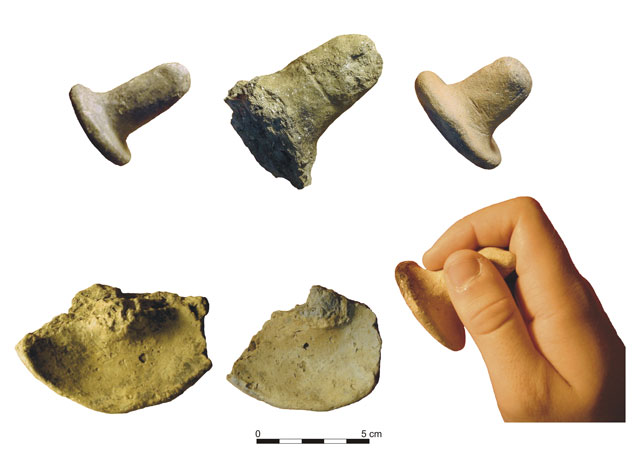Bone Bank Archaeological Research
Posey County, Indiana
Rescue Excavations at the Bone Bank Archaeological Site in Southwestern Indiana
 Introduction
Introduction
 Indiana's First Archaeological Excavation
Indiana's First Archaeological Excavation
 Survey and Testing
Survey and Testing
 Significance
Significance
 Project Goals
Project Goals
 Research Stages
Research Stages
 Expected Results
Expected Results
 Bone Bank in 2000
Bone Bank in 2000
 Planning for 2001
Planning for 2001
 Current Work
Current Work
 In the News
In the News
 Fall 2001 Lecture
Fall 2001 Lecture
 References
References
 Geomorphological History
Geomorphological History
 Links
Links
 Maps
Maps

SITE SIGNIFICANCE
The Bone Bank site is historically significant: It is the location of what may be the first reported archaeological site in Indiana, and it is certainly the site of the first excavation in the state to collect archaeological materials.
Moreover, the site is archaeologically significant for the information it can yield about one of the four main villages of the Caborn-Welborn culture, and about how inter-community relationships may have changed over time.
Restored segment of a jar from sherds found in test Units C and F, Caborn-Welborn Decorated. (Compare with Charles Alexander Lesueur's illustration of decorated jars (Indiana's First Archaeological Excavation, 41205 and 41207).

Bone Bank is one of only three large villages of the Caborn-Welborn culture in Indiana. Another large village (Slack Farm) is located nearby in Kentucky. The size of the nearby, intensively occupied Welborn site -- one of the type sites for the phase -- is unknown. Welborn is located just below a former Ohio River dam (No. 49), and water from the spillway washed away most traces of the site. Of the known large villages, Bone Bank is the only one situated along the Wabash River and the former lake at Cypress Slough. Smaller Caborn-Welborn communities were located in the surrounding area, as our continuing surveys are revealing. It is tempting to think of the smaller outlying communities as "satellites" of the large villages, but was this the case? Or, instead, were the small communities politically and economically independent?
For the long-range goal of understanding the development and decline of the Caborn-Welborn culture, it is essential to know the site-specific characteristics of each of the remaining main communities. In addition, we need to gain a sense of their role with respect to outlying settlements-- smaller villages, hamlets, and farmsteads -- in terms of the subsistence economy, local and long-distance exchange, social and political patterns, and temporal dynamics. Because the archaeological deposits at Bone Bank sites retain integrity on both the ridge crest and in the buried midden deposits along the swale and slough, we can recover some of the kinds of materials and associations needed to characterize this community.
Excavation of buried midden deposits, Fall 2000, North Block.

The key questions for Bone Bank are: How long did the Caborn-Welborn people live at this site? How does the dating for this site compare with others nearby? What was the economy of the Bone Bank villagers? Did subsistence practices differ between the village on the Wabash, and those near the Ohio River (Hovey Lake, Murphy)? What practices distinguished the Bone Bank villagers from their contemporaries; did they decorate their pottery, or weave their fabrics, in a distinctive manner, compared other villages? Or were the techniques, motifs and embellishments common among most communities? What is the evidence for long distance trade? Was Bone Bank a fortified village, as would be indicated if a stockade wall is present around the remaining southeast village segment on the ridge crest?
These research questions can be answered only with a promptly executed program of rescue excavation and laboratory study directed toward the remaining archaeological deposits on the ridge crest and in the buried middens.
Examples of one artifact type -- pottery trowels -- found at several Caborn-Welborn villages. Trowels were made of fired pottery and used in the manufacture of pottery bowls and jars during the stage of shaping the vessels. The trowel was held on the inside of the vessel and the exterior was patted with hand or paddle to thin the vessel walls. (Top row, Murphy site, small and large trowels; lower right, Hovey Lake site, small trowel held in hand; lower left and center, Bone Bank, fragments of large trowels.

Return to Top
Last updated on 8/06/2001
Send Comments to: munsonc@indiana.edu
Site sponsored by Indiana University
 Introduction
Introduction
 Indiana's First Archaeological Excavation
Indiana's First Archaeological Excavation
 Survey and Testing
Survey and Testing
 Significance
Significance
 Project Goals
Project Goals
 Research Stages
Research Stages
 Expected Results
Expected Results
 Bone Bank in 2000
Bone Bank in 2000
 Planning for 2001
Planning for 2001
 Current Work
Current Work
 In the News
In the News
 Fall 2001 Lecture
Fall 2001 Lecture
 References
References
 Geomorphological History
Geomorphological History
 Links
Links
 Maps
Maps



